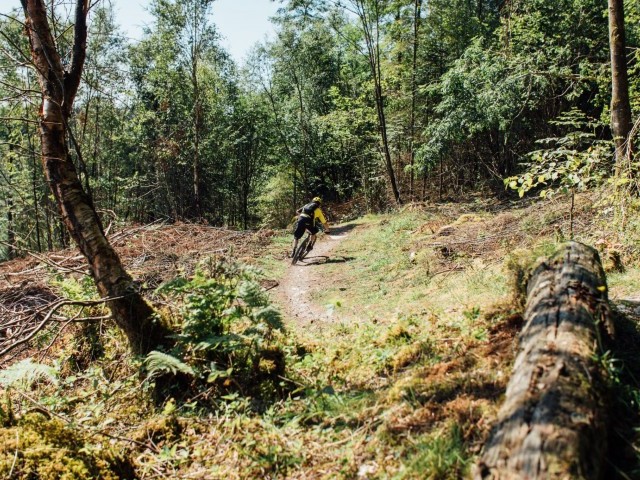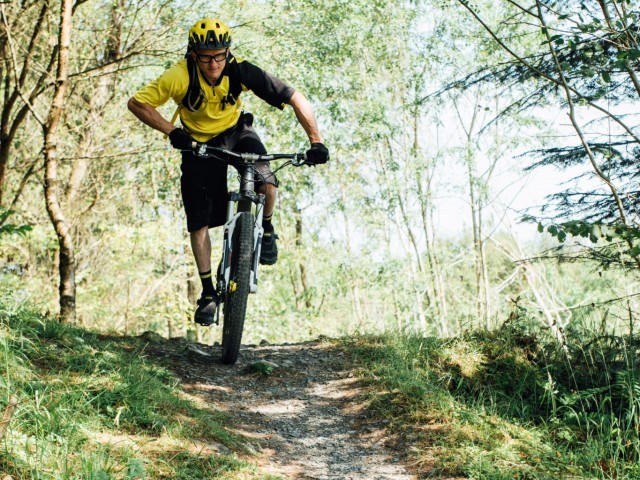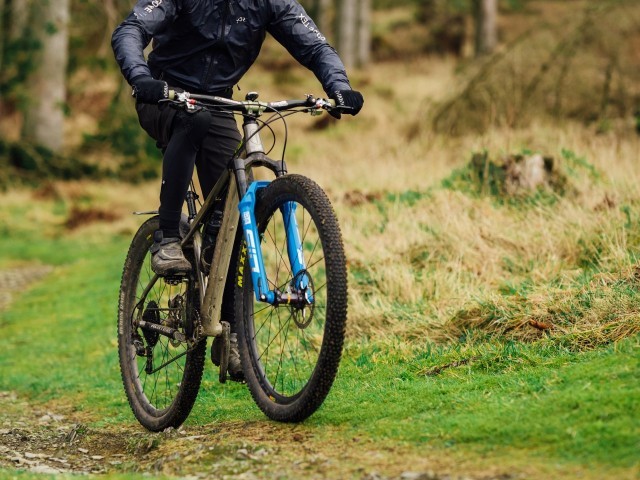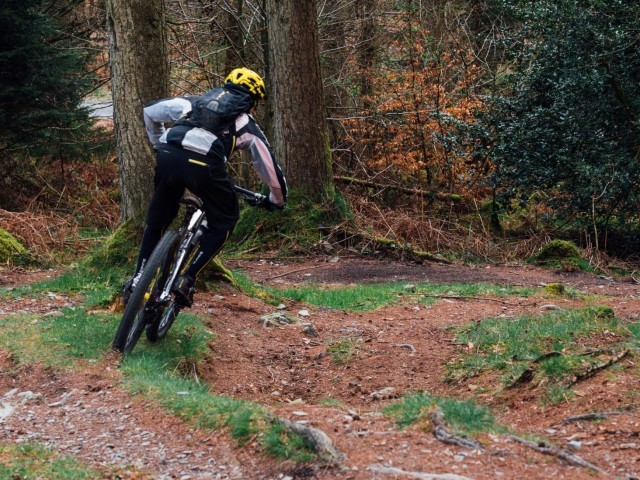
The Bunny Hop
Technique / Skills
I Said A Hip Hop
Hippie to the hippie, The hip, hip a hop, and you don't stop, a rock it out
Now, what you hear is not a test I'm rappin' to the beat... and for those of you not familiar with the hit track “Rappers Delight” by the Sugar Hill Gang I’ll crack on with this editions skill, the bunny hop. However, just quickly before I ramble on I want to wish our Editor and chief Rou a speedy recovery as he ‘hops’ around on one foot having snapped the other off by crashing out in the Alps last month.
For me the bunny hop is a skill that can really open up terrain and the possibilities on the bike. There comes a time (especially in technical terrain) where our speed is so great and obstacles are so sizeable that without lifting the bike up into the air and over them we are going to get a nasty shock. The manual bunny hop is a technique that enables us to carry that speed and put the bike exactly where we want on the trail.
Learning ‘proper’ manual hops will give you a skill that is safe and effective, the techniques used are dynamic and explosive and will burn some diesel but the energy expelled to hop the bike will be paid back by the ability to maintain rhythm and flow through the terrain. By not having to pedal back up to speed having slowed and rolled over or through a feature you can also set up for the next feature better, often-complex technical sections involve several hops or bump hops in succession.
What’s wrong with the two-wheeled hop?
Before we get into the nitty gritty lets look at the ‘spud hop’ (or car park hop) and see just why it’s lame and dangerous. To lift the bike up vertically and ‘hop’ two wheels into the air simultaneously requires the rider to first ‘press’ or ‘bounce’ the bike, this could lead to stalling the bike further as the riders energy (bounce force) is going downwards into the terrain, which is often rough in mountain bike terms.
Following the press, stomp, bounce or whatever you want to call it comes the ‘tug’ or ‘lifting’ of the bike. At this point the rider is bringing the limbs up into the body, they are focusing their strength and effort into ‘lifting’ the bike, through trying to achieve this lift with both arms and legs at the same time. The distribution of ‘effort’ becomes unbalanced from front to rear; obviously we can only really ‘actually lift’ upwards and bring the bar close to the chest with the arms whilst the legs are either ‘tugging’ upwards on clip in pedals or trying to get traction on flats to scrape/lift the bike up - aka the dog sh*t wipe technique as sometimes described.
This uneven distribution of forces puts bike and body in such a position that is hard to get
- A) Big lift / height
- B) The bike to move laterally
Consider the distance the bike has to travel just to clear a finely painted line on the ground, over a bike length when measured from tyre contact patch to contact patch. This is a long way and a lot of effort for such a small feature. Now lets consider the same but when a rider uses the old school “American Bunny Hop” aka manual-hop.
The lift is initiated by performing a manual, this natural shape (think how people jump in athletics - long jump / high jump) utilises the whole body (throwing arms before legs) and takes advantage of the mechanics of the bike and the principles of levers and pivots. The rider being up on one wheel having pulled a manual rolls in deeper to the line, as the rear wheel nears the line (if timed right) the bike is ‘loaded up’ through the back end (the riders body is also loaded up) and that energy is released as the rider thrusts the bike upwards and forwards.
The rider lifts the legs to remove their mass from the rear of the bike and by lifting them at the same rising rate that the bike is coming up they can get some serious air under them. Limbs extend as the bike is in flight and the landing is absorbed.
A big plus here is that while the manual part of the lift is happening the rider can ‘turn in’ and strike an arc thus creating lateral movement. The legs can further assist as the back end comes airborne by ‘kicking’ the bike over in the desired direction. This lateral movement (lateral bunny hop) is ideal for cutting from one side of the trail to the other, you may have seen the videos where riders leap out of one berm and transfer across into another, this is the same shape just on its side (leant over) a little more. The compression in the berm assists with the ‘load-up and release’ forces required to get the bike up in the air.
Bubba to the bang bang boogie, boogie to the boogie
To the rhythm of the boogie the beat (Sugar Hill Gang - go listen)
Timing is everything, for this song and dance to come to life we have to coordinate the movements so the upper part of the body is synced with the lower. There is a rhythm, tempo and harmony to the moves, this changes with the speed we are travelling, how far / long we want to hold the manual part and how much amplitude is required. There are some things that are obvious but should be pointed out, you want to hop further - go faster. You want to hop higher - manual larger and bring them legs right up into the body while punching that bike upwards and out in front of you. As I mention nearly each edition practice makes permanent and muscle memory is key to consistency.
If your hopping well already you may get rusty and just want to brush up on things but what about those of you who are starting off from scratch and longing to leap along the trail. First tip is to go back to the homepage and select “ISSUE” and read No’ 54 so you can see how to master that manual. When you are pulling manuals sufficient enough to cover (roughly speaking) a bike length at a height high enough to get onto or over something around the height of your crank set (chainrings) then pick up again from here.
With the manual in the bag and developing we need to get some air under our rear wheel. We can learn an additional sneaky skill in the process here and perform a ‘rear wheel lift’.
Roll along in your neutral stance with your saddle dropped (again we can do rear wheel lifts and hops with seat up but the bike needs to pass below us and the saddle gets in the way with the post at full height), bend at the knees and lower in a vertical plane so you almost sit on the saddle. Now rise back up, repeat many times in succession and make your movement seamless without pausing when you reach the lower part of the movement.
This bottom part of our movement is where the energy is building that we need to release dynamically. The shape is the same as you would make if you were jumping on the spot, only difference here is we are rolling along on the bike and have to be careful that the crankset does not rotate round, we don’t squash into the front centre of the bike (aim to stay relatively upright by lowering hips to heels) and we let our heels drop ever so slightly by allowing the pedal to rotate around its axle. Maintaining pressure through the pedals and crankset as always is important.
The faster and more dynamic your bounce the greater the opportunity for lift, to increase the lift when you are back tall and proud lift the legs up into the body - knees to chest, heels to hips. Now we have learnt the rear wheel lift we can start to stitch moves together.
Roll along at jogging pace, perform a small manual and then almost immediately after a rear wheel lift. You can pick an object like a small stick to use to help with timing. Empty car parks and the white lines from the parking bays are perfect. Decrease the pause between manual and rear wheel lift and you will soon start to make small hops by lifting independently the front and rear wheel.
To stitch together a real sweet well timed hop think about popping up off your heel just as your front wheel reaches its maximum height. Try holding a manual a little longer then popping that rear wheel lift, to hop higher pull a bigger manual. Mess around with various combos and see through the feeling how the timing changes. You will just instinctively know when it’s just right and well executed as it ‘clicks’, that sweet spot where all movements flow and the hop seems effortless.
The next progression is learning to hop sideways, we do this by starting to turn a corner as the manual is initiated, practice doing manuals round corners first. As the front wheel reaches its maximum lift spring up and punch that bar out up and away from you while bringing the legs up using extra effort in the trailing foot to kick the bike across sideways. As the trailing foot does the most work and for super tech terrain it’s recommended to learn to hop in switch stance (left foot forward and right foot forward).
Progression is everything if you want to ride the seemingly unrideable. Good hoping technique opens up sections that before were slow and picky or just simply unrideable. Hops allow us to pre jump features and match the shape of the bike to the shape of the terrain far better. Being able to place the bike into a back-slope gives us added speed and flow, features like wet off camber roots that would have pushed us off line become more trail fodder that gets filed into the ‘insignificant’ category enabling you to focus on the bigger ‘significant’ tasks at hand (it will feel like you have lees to do moving you from passenger to pilot with the added assistance of fly by wire).
As speed and scale increase so does the need for razor sharp timing, we go back to vision and reading ahead to weigh up the options of how to best manage the bike through the section of trail. The options available to you become almost endless and the fun (for me anyway) really begins when we get airborne. On that note all the technique gained through mastering manual hops links nicely into jumping.
But… before we get to sending jumps (and Christmas Cards - issue 57) tune back in next time as I will take you through dropping off stuff, from small features onto flat ground to drops into steep downslopes. Always a pleasure, enjoy the rest of your summer.
This technique article was in Issue 55 of IMB.
Related
By Clive Forth
Clive Forth is a rider who has been there, done that, got the t-shirt and cleaned his bike with it. He has grown with the UK scene and technological developments for the last 30 years and has competed at all levels in all disciplines riding for some prestigious brands along the way. Always looking for that extra edge with endless passion and drive he is geared up to bring you the inside line on all aspects of mountain biking skills and technique.


































